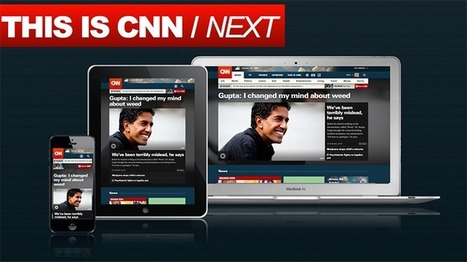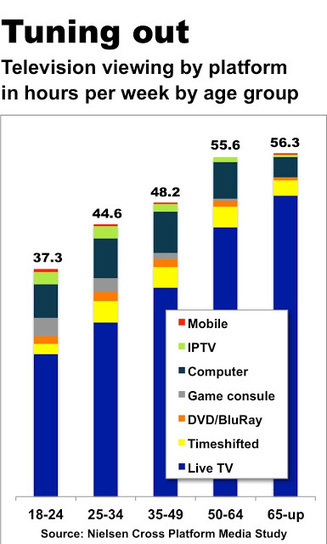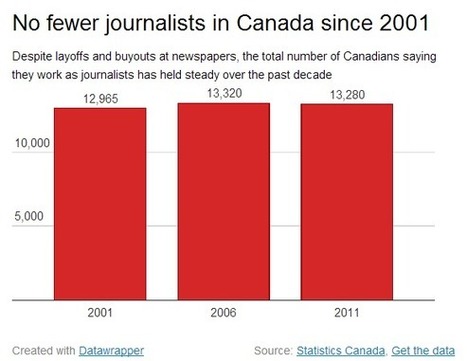 Your new post is loading...
 Your new post is loading...
...Today, the delivery of news is not so defined. Website, social media and digital platforms have profoundly changed not only how we get our news, but also what news we are getting. The comment section of online news stories are often more popular, or at least more entertaining, than the actual news story. The ability to “like” and “share” news now allows others to instantaneously watch or read what we are following.
As the number of online and social media offerings grows, we are sadly seeing the demise of newspapers. In 2011, 152 American newspapers ceased operations. Rapidly declining advertising revenues continue to be the industry’s core problem as the majority of us seek our news online.
Now, plans are in place for significant changes for CNN.com and CNN digital platforms. The channel will launch a redesigned website (see screenshots here) and install a back-end system that its editorial producers can utilize. This comes after the recent merging of their digital and television newsrooms into one entity. With a new emphasis on their talent, CNN anchors, reporters and writers will become more prominent, enabling the sharing of content across platforms....
From time to time, media reports on the latest tectonic shift in digital devices and the associated increase in time we spend online are a prophesy - the death of all TV viewing is imminent. Statements like this one recently, "the steady increase in online traffic is cannibalizing TV viewing and effectiveness," have been uttered by pundits periodically over the past decade or more, driving hysteria throughout the industry with marketers left to wonder if it is truly and finally the end of TV advertising as we know it. Isn't it inevitable?
Turns out the answer is 'yes' and 'no'. TV viewing behavior has been permanently altered, and the change (while glacial vs. 'shock and awe') has been sweeping. That said, the net real effect on TV's pivotal role as THE video medium has been minimal – indeed, online viewing has been growing in tandem with not at the expense of overall TV viewing. BOTH online and TV platforms are witnessing record engagement numbers, with television still very much at the helm. Indeed, traditional, living room, TV consumption has grown year-over-year in the U.S., and continues to dominate as consumers seek out appealing entertainment and information[1]. W
ith growing consumer appetite for content and increasing dexterity with mobile devices, adoption of smartphones and tablets will continue to rise, but ALL indications are that television will remain the glowing centerpiece in the living room for the foreseeable future....
Dear Jeff [Bezos],While it might seem an awful cliche, the fact of the matter is — if you go back to a time long before the commercial Internet existed, and well before you became so rich that you have $250 million in spare change to purchase a major metropolitan newspaper — I started my real journalism career in the mailroom at the Washington Post.
On the storied fifth floor of the Post’s longtime building at 15th and L Streets, NW — which is now also prepping to be sold for about half of what you forked over for the Post itself (oh, the irony!) — I delivered piles of letters and packages to reporters and editors, starting when I was still a student at Georgetown University.
I had come there as both a mailroom lackey and also as a stringer, after I called and chewed out then-Metro editor Larry Kramer (now the editor publisher of USA Today) about how badly the newspaper was covering the area’s colleges, including mine. He told me to come down to the Post and say it to his face, which I did with all the obnoxiousness a 19-year-old could muster.
As it turned out, I ended up staying at the Post — with a few short departures for things like graduate school — for almost 15 years, in more jobs than I can remember, including the lowest rung in the then-backwater business section. .PS Don't forget to breathe.
... However, it would be a mistake to think that just because it’s easier than ever to produce amazing digital editorial experiences that this makes organisational change easy. It takes an entirely different set of skills to get buy-in from stakeholders or to Jedi mind trick the empire builders of senior management. It is hard, and even I underestimated the size and nature of the challenge as I transitioned from young digital maverick field journalist to digital editor in the middle of the last decade.
While a lot is different in 2013 than it was in 1996 when I started in digital journalism, or even than it was five or six years ago, change still is hard. In some ways, it is even harder now as most newspapers struggle with redeploying diminishing resources carefully from the core business to new digital initiatives. The politics are fierce. Even when it is in an organisation’s best interest, even when it is an organisation’s stated interest to embrace digital, winning the political and cultural battles is hard, thankless work. I know people who stayed and fought these battles inside organisations, and I have deep respect for them and learn from them whenever possible. When I return to working for an organisation, hopefully soon, I will take lessons that I’ve learned from these friends....
Innovative storytelling, audience engagement, and financial flexibility are key ingredients for newspapers to cope with pressures from competitors, budget constraints, and the speed at which technology is changing."It came as no surprise when The New York Times took home a Pulitzer for 'Snow Fall' - the immersive multimedia package impressed journalists and web designers alike with its seamless integration of text, audio, videos, photos and interactive graphics."The comments in "Trends in Newsrooms 2013," the World Editors Forum's report on the state of the news industry, about the attention-grabbing content, underlined the importance of stories that jump out at readers....
...Turns out that what we have now are a lot of ethics codes and policies, but very little accountability.To make sense of this, here’s the kind of lapse I’m talking about, none of which seems to have been addressed.
1. NBC selectively edited a video and badly misrepresented a guy in a real ugly case. Not clear if they’ve come clean about it yet.Suggestion: News outlets should make the full recording available, perhaps via a discreet rapid-response accountability team. 2. Sometimes a news outlet might broadcast a public figure lying, even when they know it’s a lie. This is what Jon Stewart calls the “CNN leaves it there” problem.Suggestion: Reporters are smart — if they know they’re being lied to, don’t broadcast it. If they smell a lie but they’re not sure, do a good faith fact-check....
Does this signal the beginning of the end for Forbes as a knowledgeable source of business information? Have they finally "jumped the shark" on their way to the exit? "Jumping the shark" is actually an expression that goes back to the TV sitcom series, Happy Days. It was a show that pictured everything as rosy and happy, with neat little endings that were all nicely tied up in twenty-two minutes. The chief influencers on that show were "The Fonz," who only had to give you a look to let you know you were in trouble, and Mr. Cunningham, who set down the rules of the family.
In the midst of its ten-year run the writers must have gotten tired or were negatively influenced by the Hollywood decision-makers, when they inexplicably decided to have their characters travel to Los Angeles. Well, one thing leads to another and Fonzie ends up responding to an assault on his courage by taking to water skis (wearing his leather jacket of course) and jumping over a shark.
The stunt was so ridiculous and out of character that "jumping the shark" eventually came to be known as the moment when a television show begins a decline that is beyond recovery. While Happy Days bravely soldiered on for a few more years, it was never really the same in the minds of viewers and critics. Since that time the meaning has been broadened to define the moment when a brand or creative effort begins to lose the qualities that initially defined its success. Some still refer to "New Coke" as the moment when the Coca-Cola Company jumped the shark....
Beyond distribution and a better user experience, being web friendly fits into the Flipboard business plan. The company has begun selling full-page ads mixed in with regular content like what you might see in a high-end print magazine. Larger professional publishers, including the owners of this publication, currently have revenue-sharing agreements in place for their own magazines, but the company plans to expand that to other content and curation creators.
Around two million magazines have been created since the March launch of the DIY tool, and many of the top ones are being curated by enthusiasts rather than pros — photography, maritime shipping, beer, and GIFS are some example themes. There’s a lot of additional reader attention to sell against.
But what about the publications trying to figure out their online (and mobile) business models? Why should they want Flipboard to get a piece of their precious few remaining ad dollars via alternative destinations like native apps and now its own web links?For some of them/us, the answer is going to be that they don’t have the resources to build good web sites and mobile apps anyway. For others, it’s that they can build their own products but don’t know how to monetize them well....
Handheld devices such as mobile phones and tablets are on track to become the dominant platforms for news consumption, and more people are using more than one device, a survey of media consumption habits in nine countries has found.
“News is becoming more mobile, more social, and more real-time,” according to the recently released Reuters Institute Digital News Report 2013: “Tracking the Future of News,” an annual survey which monitors the transition to digital media. “The overwhelming message is that audiences increasingly expect news that they can access anytime, anywhere."
While the survey found the computer remains the primary device for accessing digital news, a third of respondents reported getting news on at least two devices, and 9 percent said they use more than three. Tablet usage doubled in the 10 months since the last survey....
I recently gave a presentation at the Digital Innovators Summit in Berlin on how FORBES is disrupting the traditional news media.
My solution was to tell the FORBES story of the last 20 months — the successes, challenges and learnings of a 95-year-old startup helping to lead journalism into the future.
I’ve boiled it down to nine key points that capture what we’ve done to reinvent Forbes.com and put our authoritative journalism at the center of a unique social media experience....
In pivoting aggressively from print to local TV, Gannett Inc. and Tribune Co. are embracing a legacy media model that could be headed for the same audience fragmentation and economic dislocation as the newspaper businesses they are trying to escape.
As detailed here yesterday, the two iconic publishing brands have announced parallel, billion-plus acquisitions that will boost their local broadcast holdings at the same time they reduce their exposure to the fraying newspaper empires on which both companies were built. Going further, Tribune is seeking buyers for some or all of a publishing portfolio that includes such prominent brands as the Chicago Tribune and the Los Angeles Times.
The long-time newspaper publishers can’t be blamed for being attracted to broadcasting. Television generated a record $49.7 billion in local and national advertising sales in 2012, while newspaper advertising revenues – which have been sliding relentlessly for seven years – ended 2012 at less than half the all-time high of $49.4 billion hit in 2005.
Though the transactions planned by Gannett and Tribune clearly reflect their confidence in the continued health of broadcasting, a look at the collapse of the once-indomitable newspaper business suggests that TV, in due course, could suffer a similar fate. We’ll review the accumulating evidence in a moment. First, here is a quick review of what happened to newspapers:...
One of the biggest complaints about online advertising is that we’ve exchanged print dollars for digital dimes.
One response has been: Well you better start stacking dimes.
The dollar to dime problem is at the heart of journalisms existential woes. I suspect if money were rolling in like it used to, the question of “who IS a journalist” wouldn’t be so passionately debated.
There is a moment I’ve called “the Screenularity“ - it is the moment when consumers do not make a functional distinction between the screens in their life. One can watch video on their handheld screen, one can make a call on the 40-inch screen in their living room. One is not called a “phone” or the other a “TV.”...
Rebecca Jarvis, business and economics correspondent for CBS News, discusses the current state of journalism, what the future holds, and why companies are scooping up journalists to create rich content for their brands.
|
Chad Skelton does a good job of explaining it. There are just as many journalists working in Canada today as there were a decade ago, according to data from Statistics Canada....
In the wake of the Boston Marathon bombing one commenter called it a “watershed moment for social media” – but not in a good way. “Legions of Web sleuths cast suspicion on at least four innocent people, spread innumerable bad tips and heightened the sense of panic and paranoia,” wrote Ken Bensinger and Andrea Chang in the L.A. Times. In a similar post, Alan Mutter quipped that crowd reporting after the Boston Marathon went from critical mass to critical mess.
Recent events like Hurricane Sandy and the Boston marathon bombing have cast a harsh spotlight on the brave new world of breaking news and highlighted the critical need for better tools and techniques for verifying and making sense of the flood of information these events produce. This has all played into the ongoing debate about whether the Internet and new technology erode our standards and our trust in newsgathering....
The question that still remains is why: Why would a technology entrepreneur invest in a stodgy media outlet in a declining industry? Was the motive for the move sentimental altruism or profit?
I think Henry Blodget at Business Insider hit the nail on the head in his piece when he said that:"Content and commerce companies have long dabbled with combining the two experiences, but no one has really nailed it. Given Amazon’s expertise in affiliate marketing and advertising, it’s not hard to imagine that the Washington Post could quickly become a laboratory for the next generation of integrated content and commerce."...
The New York Times Company did the world of journalism a big favor today.The company finally disclosed the exact revenues of its digital business.The numbers were impressive. And they made clear that no one ever needs to fret about the future of journalism again.Specifically, the New York Times reported that the revenue of its digital business is now about $360 million a year....
Does this strike you as strange? Everything I read and hear keeps telling me that newspapers are a dying industry. Circulation is way, way down. Everyone's getting information online nowadays. No one (besides me) reads newspapers any more.
So why, in the face of all this negative opinion about print media, would one of the world's most well-known and admired investors invest money in print media? I've never met Warren Buffett or had the opportunity to interview him for this column. I'm not privy to the details of this deal. And for all I know there may be a treasure chest of gold buried underneath the offices of the Press of Atlantic City.
But assuming that's not the case, I can think of a few good reasons why he would do this--reasons that have little to do with the newspaper business, but have a lot to do with business in general....
On top of the shifts in time spent with media and the fragmentation of audience engagement, media companies are also challenged with shifts in revenue. More traditional media companies like newspapers, radio, local TV stations, direct mail, and directories experienced a total decline in revenue ranging from $25 million to $1.7 billion from 2012 to 2013 according to Borrell Associates 2013 Local Advertising Outlook.
All of these factors are taking a big toll on media companies, forcing leaders at media companies to face their challenges head on. As I speak with more and more consultants, General Managers, VPs of Sales, and Directors of Marketing they tell me that if their companies don’t adapt to accommodate their audience and their advertisers, they’re going to fall behind. Here are the top challenges these media companies have shared with me, and how we believe inbound marketing can help them meet and defeat those obstacles....
... It was an industry-wide response, and readers noticed, Brusic said. "Imagine it's your daily coffee. Each time you put down your money the cup gets smaller and the brew gets weaker. That's essentially what's happened to American newspapers. We took things away from people and at the same time gave content away free on the web. How crazy is that? The industry committed a kind of institutional suicide over time."Some, like the Rocky Mountain News, closed. Others, like the San Francisco Chronicle, limped on, feeble, malnourished versions of former selves....
When it comes to political scandal, why is the media is so out of step with its audience?
Spitzer and Weiner, with their cohorts around the country, are a slap in the media's face. Scandals, after all, are largely media created. You can hardly have a scandal without the media treating it as scandal — Spitzer's and Weiner's being among the tastiest of recent years.
There's a vested interest here. The media is defending its own work. The easy rehabilitation of the badly behaved refutes, if not the facts, certainly much of the media's damnation.While the media has been the instrument of running the offenders out of office, the public wants them back....
How do you get your news? Personally, I get mine primarily from Facebook. As my job requires that I monitor and update different brands' pages, it's pretty likely that you'll find me with the Facebook tab open.... While I may be an addict—I mean hello, it is my job—I am not the only one who scours social networks for news. According to a Pew study, one third of adults under 30 access their news via social networks. 19% of all Americans got news from a social network like Facebook, Google+ or LinkedIn yesterday (up from 9% in 2010). This study was conducted in 2012. Being that we're now in 2013, I can only imagine it being a higher percentage to date....
Whenever a major news story breaks, the talk quickly follows from the news itself to how social is killing mainstream media. While there is merit behind this argument, they tend to neglect one major factor....
Every time a major event happens, the same thing happens. Story breaks on Twitter, people retweet it and then the many media organisations are lambasted for taking 20-30 mins to report on it and then the debate of how mainstream media is dying because of how slow it is.This debate happens every single time and the Boeing 777 plane crash on Saturday was the latest example of this.
But why is there an "us versus them" debate every time traditional and new media is compared? Especially since neither is perfect by any means. True, daily newspapers are suffering because of falling advertising, but for other mediums like weekly newspapers, magazines, radio and TV, why are we still talking about them as if they're in direct conflict with social?
The Wrong QuestionThe question that should be asked isn't which is better, but which one best suits the way you consume media? Both mediums have their own strengths and weaknesses and instead of pitting both against each other, why can't we appreciate both for what they are?...
Winning in digital media now boils down to a simple equation: figure out a way to produce the most content at as low a cost as possible.
In recent years, new players like The Huffington Post burst onto the scene by pumping out a dizzying amount of content each day. The company has 532 full-time editorial staff producing about 1,200 pieces of content per day (and that’s not including the 28 full-time blog editors who oversee the 400 pieces of content per day coming from its blog). All this content generates 43 million pageviews per day, per Comscore. The pageview race now stretches far beyond HuffPost, as many publishers combat low ad prices with high volume.
Even old publications, like Forbes, are taking part in the pageview race. It has 50 on its editorial team. However, it also has about 1,000 contributors. Between the two, Forbes puts up about 400 posts per day and sees 4 million pageviews per day, per Comscore. The company doesn’t separate out how much the staff and contributors put out. But last year, the company posted its best financials since the 2008 industry collapse and saw digital ad revenue spike 19 percent year-over-year. Quantity pays the bills....
There were 2,600 less full-time professional editorial jobs at newspapers in 2012, a 6.4% drop from 2011, according to The American Society of News Editors’ latest annual newsroom census figures.
Pew Research has more: “That leaves the industry at 38,000 full-time professional editorial employees and is the first time that figure has been below 40,000 since the census began in 1978. The losses are also more than twice the level estimated in March by Rick Edmonds, coauthor of the chapter on newspapers in the Pew Research Center’s State of the News Media report.”
|



 Your new post is loading...
Your new post is loading...




































This is a really interesting look at news media and journalism trends as well as a specific preview of changes at CNN as it integrates its traditional and digital newsrooms. Recommended reading.